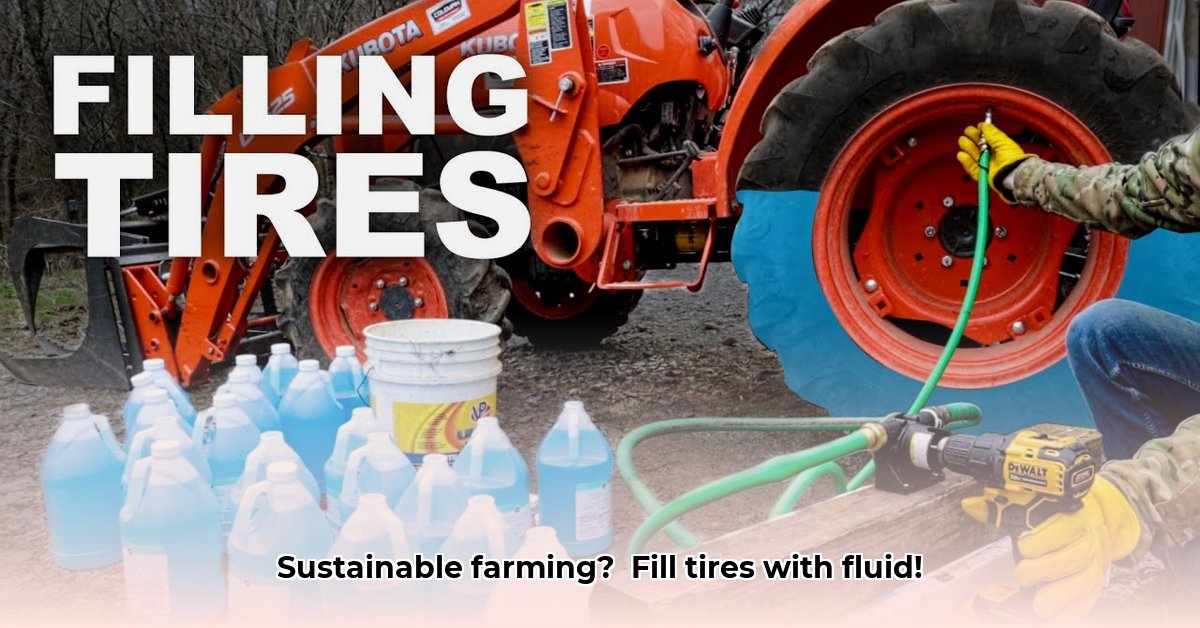
Choosing the Right Ballast Fluid for Optimal Tractor Performance
Filling tractor tires with fluid ballast significantly enhances stability and traction, boosting efficiency and reducing fuel consumption. However, selecting the appropriate fluid requires careful consideration of various factors including cost, environmental impact, and safety. This comprehensive review analyzes common ballast options, guiding farmers and stakeholders towards informed decisions. A key question to consider is: What factors beyond initial cost should influence the choice of tractor tire ballast? For more detailed instructions, see filling tractor tires.
Ballast Fluid Options: A Comparative Analysis
Several options exist beyond the traditional choice of water, each with distinct advantages and disadvantages. This comparative analysis considers water, beet juice, propylene glycol antifreeze, and calcium chloride. Windshield washer fluid is strongly discouraged due to its potentially harmful chemical composition and inadequate freeze protection.
Performance Characteristics
The following table compares key performance indicators of each ballast fluid:
| Ballast Type | Weight Density (lbs/gal) | Freezing Point (°F) | Traction/Stability | Corrosion Potential | Notes |
|---|---|---|---|---|---|
| Water | 8.34 | 32 | Moderate | Low | Inexpensive, readily available; freezes easily, limited weight density. |
| Beet Juice | ~9.5 | 28-30 | High | Low | Higher cost, availability varies regionally; good freeze protection. |
| Propylene Glycol | ~9.8 | -35 | High | Low | Excellent freeze protection; higher cost, moderate environmental impact. |
| Calcium Chloride | ~12 | -50 to -60 | High | High | Low cost; highly corrosive, hazardous waste disposal, significant environmental concerns. |
Note: Weight density and freezing points are approximate and may vary based on concentration.
Cost Analysis
Cost considerations extend beyond the initial purchase price of the ballast fluid. Factors such as volume required (depending on tire size and tractor application), potential maintenance costs due to corrosion, and disposal fees must be factored into the total cost of ownership. A comprehensive cost comparison across different farm sizes and applications is beyond the scope of this article, but the initial cost per gallon provides a starting point for assessment.
| Ballast Type | Approximate Cost/Gallon |
|---|---|
| Water | $0.10 - $0.20 |
| Beet Juice | $0.50 - $1.50 |
| Propylene Glycol | $1.00 - $2.00 |
| Calcium Chloride | $0.25 - $0.50 |
Environmental Impact
Environmental considerations are critical, encompassing manufacturing, transportation, use, and disposal. Water has a minimal environmental impact, while beet juice utilizes an agricultural byproduct, reducing waste. Propylene glycol has a moderate environmental impact, whereas calcium chloride poses significant environmental risks due to its corrosive nature and hazardous waste disposal requirements. A full Life Cycle Assessment (LCA) for each option would provide more precise comparative data.
Safety Considerations
Safety protocols are crucial. Water is generally safe, while beet juice poses minimal risks under normal conditions. Propylene glycol has relatively low toxicity compared to older antifreeze formulations, but appropriate handling precautions are necessary. Calcium chloride is corrosive and requires stringent safety measures. Detailed safety data sheets (SDS) for each fluid should be consulted before use. What safety measures should farmers take when handling different ballast fluids?
Regulatory Compliance
Regulations regarding ballast fluid usage and disposal vary by region. Farmers should consult local and national environmental agencies to ensure compliance with all relevant regulations. Furthermore, manufacturers and researchers should advocate for clear and consistent ballast fluid regulations to foster environmentally sound practices.
Actionable Recommendations
These recommendations are tailored to different stakeholders:
Farmers: Choose a ballast fluid that matches your budget, climate, and environmental priorities. Carefully consider the long-term costs and environmental impact. Prioritize safety throughout the process.
Equipment Manufacturers: Design tires with improved corrosion resistance to extend their lifespan. Investigate and develop sustainable ballast fluid options.
Government Agencies: Implement regulations that promote the use of environmentally friendly ballast solutions while ensuring farmer safety.
Researchers: Conduct further research to develop and evaluate more sustainable and cost-effective ballast alternatives. Focus on biodegradable and non-corrosive materials.
Conclusion: Building a Sustainable Future for Agriculture
Selecting the optimal tractor tire ballast fluid is a multifaceted decision. While initial cost is a factor, it is crucial to consider long-term costs, environmental implications, and safety. By considering all variables, farmers and other stakeholders can contribute to more sustainable and efficient agricultural practices. The choices made today will shape the future of sustainable agriculture, underscoring the importance of informed decision-making in this crucial area.